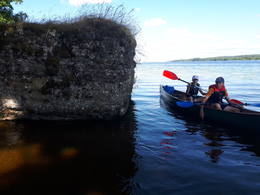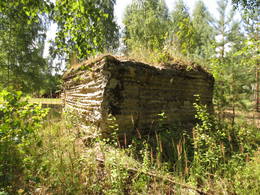Aktoriaus Harijaus Liepinio prisiminimai apie tarnybą Vokietijos armijoje
Vėliau išpopuliarėjęs aktorius Harijs Liepiņš buvo pašauktas į Vokietijos armiją ir 1944 m. rudenį išsiųstas į Kegumą.
„Esame vežami į priešlėktuvines baterijas ir mokymus Kegume – zonoje, kareivinėse prie elektrinės ant Dauguvos kranto. Pirmąją mokymų dieną esame supažindinami su vokiška geležine drausme, ji žemina, griauna bet kokią savigarbą ir protesto dvasią.“
...Esame sugedę, tik nevalingi varžteliai, kuriuos galima pamažu įstatyti į didžiąją karinę mašiną.
Pagaliau ateina istorinė akimirka – priesaika Hitleriui ir Vermachtui. Stovime uždaroje eilėje ant patyrusios Dauguvos kranto. Per garsiakalbius skamba Vagnerio muzika, plevėsuoja vėliavos. Ant platformos vokiečių pulkininkas pradeda savo iškilmingus žodžius, kuriuos verčia latvių kapitonas, ir mes turime juos pakartoti pakelta ranka. Pasiekiame pirmojo sakinio vidurį: „Aš, jaunas Didžiosios Vokietijos kareivis...“ – kai į pagalbą ateina rami Dauguvos sąžinė ir Stalino „ereliai“. Bombonešių eskadrilės ataka nutraukia gėdingą ritualą. Bombos sprogsta, ir visi karininkai ir puskarininkiai kartu su jaunais kareiviais krenta vienas šalia kito netoliese esančiuose bulvių laukuose. Dėl 800 metrų aukštyje dislokuotų priešlėktuvinių atakos balionų pataikymų nedaug, kyla didelė panika. Vagnerio „Dievų prieblanda“ toliau skamba tarp riaumojimų ir švilpimų... Po to ore dar ilgai tvyrojo parako kvapas, čia ir ten jis degė. Iškilminga ceremonija nebuvo pakartota. Ir taip, pusiau nuoširdžiai, mano priesaika „vadovams“ baigėsi, ir man niekada gyvenime nereikės atsakyti jokiam neofašistui už jos sulaužymą ar nesilaikymą.“
Andersone, R. 2004. Kegumo hidroelektrinė. 69 psl.
Susijusi laiko juosta
Susijusios temos
Susijusios vietos
Vokiečių armijos betoninis ugnies punktas prie Kegumo HE rezervuaro Žegos upės žiotyse
Įsikūręs Kegumo HE rezervuare prie Žegumo upės žiočių (priešais Žegumo namus), kairiajame jos krante. Vienas vizualiai ir vaizdingai įspūdingiausių bei geriausiai išsilaikiusių betoninių gaisrinių, skalaujamų Dauguvos bangų. Jį galima pamatyti iš didesnio atstumo. Nuo kranto iki gaisrinės viršūnės (apaugusios žole) pastatytas pėsčiųjų tiltas. Į gaisrinės betonines sienas įmūryti siaurojo geležinkelio (?) bėgiai. Į jį galima patekti nuo pėsčiųjų tilto. Tai vienas iš Vokietijos armijos Pirmojo pasaulinio karo gynybos linijos ugnies taškų kairiajame Dauguvos krante, kurį galima daugiau ar mažiau atsekti per visą Dauguvos kairįjį krantą. Minėta gynybos linija yra didelio masto karinė sistema, kuri dar nėra iki galo įvertinta kaip vientisas darinys. Gaisrinės liekanas galima apžiūrėti plaukiant valtimi Kegumo HE.
Vokiečių armijos betoninis ugnies punktas viršutiniame Kegumo HE krante priešais Andulį
Jis yra apie 1,2 km į rytus nuo nedidelio upelio, išplatėjusio (upelis įteka į Lejasgrantinius) stataus Kegumo HE kranto šlaito viršuje priešais Andulius. Šioje vietoje krantas apaugęs mišku ir pomiškiu, todėl tik atidus stebėtojas pastebės šį gaisro tašką iš rezervuaro pusės. Gaisro taškas yra gerai išsilaikęs, nes jo nepažeidė kranto erozija. Tai vienas iš Vokietijos armijos Pirmojo pasaulinio karo gynybos linijos ugnies taškų Dauguvos upės kairiajame krante, kurį galima daugiau ar mažiau atsekti per visą Dauguvos upės kairįjį krantą. Minėta gynybos linija yra didelio masto karinė sistema, kuri dar nėra tinkamai įvertinta kaip vientisas darinys. Gaisro tašką galima apžiūrėti plaukiant valtimi Kegumo HE, nes jis yra privačioje teritorijoje.






